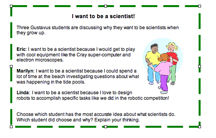Formative Assessment Probes
The brief, formative assessment resources included with these units are called "assessment probes." They are called "probes"  because they are designed to probe and uncover student thinking. Teacher and researcher Page Keeley has written extensively about the probes as part of the Curriculum Topic Study approach to analyzing science and mathematics topics. See the Curriculum Topic Study website for more information. These probes are designed to be used diagnostically and formatively. They are intended to help you to tap into students' thinking about particular science topics -- topics that are identified by the National Science Education Standards as significant and developmentally appropriate for the target age level of the unit. While they are intended to sample students' thinking (and to probe for common misconceptions), they are NOT intended to measure what students have learned as a result of the unit content. We encourage you to use these tools--and to develop your own--to better understand each student's development as a learner, and to modify your teaching accordingly.
because they are designed to probe and uncover student thinking. Teacher and researcher Page Keeley has written extensively about the probes as part of the Curriculum Topic Study approach to analyzing science and mathematics topics. See the Curriculum Topic Study website for more information. These probes are designed to be used diagnostically and formatively. They are intended to help you to tap into students' thinking about particular science topics -- topics that are identified by the National Science Education Standards as significant and developmentally appropriate for the target age level of the unit. While they are intended to sample students' thinking (and to probe for common misconceptions), they are NOT intended to measure what students have learned as a result of the unit content. We encourage you to use these tools--and to develop your own--to better understand each student's development as a learner, and to modify your teaching accordingly.
Ongoing assessment throughout the investigations is important for several reasons. It can reveal when students are confused or have misunderstandings, need more time to investigate, or need more explanation. You can tailor the investigations to meet the needs of your students, and change direction whenever necessary. Frequent assessment does not have to be time consuming or tedious. A quick assessment can give you a lot of information about student comprehension and understanding.
Purpose
The purpose of this assessment probe is to elicit students’ ideas about what scientists do.
Explanation
Marilyn's is the best response because the process of asking and seeking answers to questions about the natural world is key to science. Scientists may or may not use technological tools and engineering solutions in their investigations.
Administering the Probe
This probe is meant to be used to discover what students think about what scientists do. It may also uncover ideas about the nature of science and the role of technology in science. This unit provides excellent opportunities to explore the differences between science and technology as it spends considerable time in exploring the technology that allows scientists to investigate the ocean environment.
Grade Level Curricular and Instructional Considerations
"This level is a good time to introduce stories (true and fictional) of scientists making discoveries – not just world-famous scientists, but scientists of very different backgrounds, ages, cultures, places, and times." (Benchmarks for Science Literacy, p. 12)
"Teachers should continue to seize opportunities for introducing information on science as a diverse line of work. Above all, children in early adolescence need to see science and science-related careers as real options for themselves personally." (Benchmarks for Science Literacy, p. 17)
Many of the examples in this unit are examples of field science and exploration that may not focus on a specific testable question but use scientific methods as well as technological solutions. Students often have difficulties distinguishing between science and technology. They need real world problems to work with and to consider the impact each has on the other. Students should be working towards an understanding that science answers questions and engineering and technology solve discrete problems within constraints. With the more concrete goals of engineering experimentation, students may be able to think in an engineering way prior to being able to think in a completely scientific way.
As students examine questions and problems it is important to differentiate between the scientific model of experimentation (with a goal of understanding relationships and causes and effects) and the technological or engineering model of experimentation (with a goal of producing a desired outcome) or even a non-scientific question.
Students may believe that scientists and engineers know all the facts and are not influenced by personal motives or interests. Scientists may also believe they are more capable of making decisions about public issues than the general public and that science affects society in more positive ways than technology.
"As students begin to think about their own possible occupations, they should be introduced to the range of careers that involve technology and science, including engineering, architecture, and industrial design." (Benchmarks for Science Literacy, p. 46)
Experiences in which students actually engage in scientific investigations help them begin to understand the nature of scientific inquiry and develop an appreciation of the history of science. Historical examples help students see the scientific enterprise as a philosophical, social, and human effort. In the middle school years students' scientific experiences can be complemented by activities meant to meet a human need, solve a human problem, or develop a product – an engineering or design problem with a desired outcome. (National Science Educations Standards, p. 170)
Related National Science Education Standards5-8 Science and Technology
- Many different people in different cultures have made and continue to make contributions to science and technology.
5-8 Science in Personal and Social Perspectives
- Scientists and engineers work in many different settings, including colleges and universities, businesses and industries, specific research institutes, and government agencies.
5-8 History and Nature of Science
- Women and men of various social and ethnic backgrounds – and with diverse interests, talents, qualities, and motivations – engage in the activities of science, engineering, and related fields such as the health professions. Some scientists work in teams, and some work alone, but all communicate extensively with others.
Related Benchmarks for Science Literacy
6-8 Scientific Inquiry
-
Scientists differ greatly in what phenomena they study and how they go about their work. Although there is no fixed set of steps that all scientists follow, scientific investigations usually involve the collection of relevant evidence, the use of logical reasoning, and the application of imagination in devising hypotheses and explanations to make sense of the collected evidence.
6-8 The Scientific Enterprise
-
Important contributions to the advancement of science, mathematics, and technology have been made by different kinds of people, in different cultures, at different times.
-
Until recently, women and racial minorities, because of restrictions on their education and employment opportunities, were essentially left out of much of the formal work of the science establishment; the remarkable few who overcame those obstacles were even then likely to have their work disregarded by the science establishment.
-
No matter who does science and mathematics or invents things, or when or where they do it, the knowledge and technology that result can eventually become available to everyone in their world.
- Scientists are employed by colleges and universities, business and industry, hospitals, and many government agencies. Their places of work include offices, classrooms, laboratories, farms, factories, and natural field settings ranging from space to the ocean floor.
6-8 Technology and Science
- Engineers, architects, and others who engage in design and technology use scientific knowledge to solve practical problems. But they usually have to take human values and limitations into account as well.
Related Probes in Uncovering Student Ideas in Science by Page Keeley
Is it a Model? V4, p.
Doing Science V3, p.93
Is it an Animal Vl, p.117










